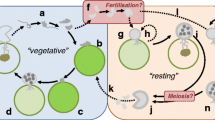Summary
The zoosporangial zoospores ofOlpidium brassicae are uniflagellate (fig. 1). Observations with a phase contrast microscope on living zoospores in watermounts showed that biflagellate zoospores resulted from zoospore fusion. Further, specimens were found with more than two flagella (fig. 2 and 3). As at zoospore discharge only uniflagellate zoospores occur, it may be, assumed that zoospores with more than two flagella are also the result of zoospore fusion. As there may be an analogy betweenO. brassicae andO. viciae,Kusano's explanation of the occurrence of compound zoospores with more than two flagella is discussed.
Similar content being viewed by others
Literatuur
Couch, J. N. — 1941. The structure and action of the cilia in some aquatic Phycomycetes. Am. J. Bot. 28: 704–713.
Kole, A. P. — 1954. A contribution to the knowledge of Spongospora subterraea (Wallr.) Lagerh., the cause of Powdery Scab of potatoes. T. Pl. ziekten 60: 1–65.
Kusano, S. — 1912. On the life history and cytology of a new Olpidium with special reference of a copulation of motile isogametes. J. Coll. Agr. IV, 3: 141–199.
Author information
Authors and Affiliations
Rights and permissions
About this article
Cite this article
Kole, I.A.P. Waarnemingen over het gedrag van zoösporen uit de zoösporangia vanOlpidium brassicae (wor.) dang. Tijdschrift Over Plantenziekten 60, 135–137 (1954). https://doi.org/10.1007/BF01988484
Received:
Issue Date:
DOI: https://doi.org/10.1007/BF01988484




